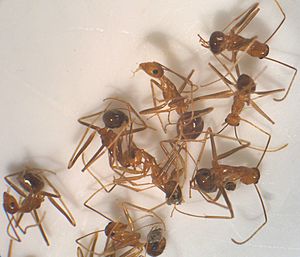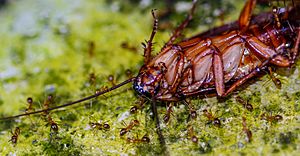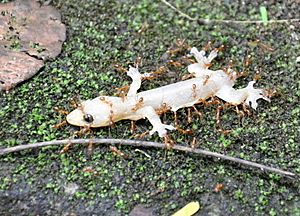Yellow crazy ant facts for kids
Quick facts for kids Anoplolepis gracilipes |
|
|---|---|
 |
|
| Scientific classification | |
| Genus: |
Anoplolepis
|
| Species: |
gracilipes
|
| Synonyms | |
|
Formica longipes |
|
The yellow crazy ant (scientific name: Anoplolepis gracilipes) is a type of ant. It's also called the long-legged ant or Maldive ant. These ants are believed to come from Asia. However, they have accidentally traveled to many warm, tropical parts of the world.
People call them "crazy" because they move in a very jerky, unpredictable way when something disturbs them. With their long legs and antennae, they are one of the biggest invasive ant species around. Invasive species are animals or plants that spread to new places and harm the local environment.
Yellow crazy ants are known as "tramp ants." This means they can easily settle and take over new areas. They do this because they are aggressive towards other ant species. But they are friendly to ants from their own colony. They also gather food very well and live in huge colonies.
The International Union for Conservation of Nature (IUCN) lists the yellow crazy ant as one of the "one hundred of the world's worst invasive species." They have invaded places like Hawaii and the Seychelles. On Christmas Island in the Indian Ocean, they have even formed giant supercolonies.
Scientists discovered something very special about these ants in 2023. They found that male yellow crazy ants are "chimeras." This means their bodies are made of cells from two different genetic sources. It's a very unusual way for animals to reproduce!
Contents
What Do Yellow Crazy Ants Look Like?
The yellow crazy ant is a fairly large ant. It is usually yellow to orange in color. These ants have long legs, big eyes, and very long antennae.
It can be tricky to tell them apart from other ants. For example, ants like Leptomyrmex and Oecophylla also have long legs and are similar in size. But you can spot a yellow crazy ant by looking for a special opening called an acidopore on its body. Also, its "waist" (called a petiole) is more compact than some other ants.
Yellow crazy ants are found all over warm, tropical areas. They are especially common in the Pacific Ocean region. They are well-known for causing big problems on Christmas Island. These ants can seriously harm the local plants and animals. That's why strong quarantine rules are important. These rules help stop them from spreading to new places.
Where Do Yellow Crazy Ants Live and How Do They Spread?
Yellow crazy ants originally come from the warm, wet lowlands of Southeast Asia. They also lived on islands nearby in the Indian and Pacific Oceans.
Now, these ants have spread to many other tropical and subtropical places. This includes northern Australia, islands in the Caribbean, and many islands in the Indian and Pacific Oceans. Some of these places are the Seychelles, Madagascar, Hawaii, and the Galapagos archipelago. They can live in many different places, even on farms growing cinnamon, coffee, or coconuts.
These ants can spread easily because they build nests almost anywhere. They often travel long distances by hitching rides on trucks, boats, and other human transport.
Naturally, ant colonies spread by "budding." This is when some queens and workers leave their old nest to start a new one nearby. They rarely fly to new places. When they spread by budding, they usually don't go very far on their own. For example, in the Seychelles, they moved about 400 meters (about 1,300 feet) in a year. But on Christmas Island, they spread faster, about 3 meters (10 feet) each day, which is about 1 kilometer (0.6 miles) per year.
What Do Yellow Crazy Ants Eat?

Yellow crazy ants are "scavenging predators." This means they hunt for food and also eat things that are already dead. They eat many different kinds of food, which is common for invasive species.
Their diet includes grains, seeds, and small creatures like arthropods. They also eat decaying things, such as dead animals. They have been seen attacking and breaking apart small animals like isopods, spiders, land crabs, earthworms, and other insects.
Like all ants, yellow crazy ants need two main types of food. The queen needs lots of protein to lay eggs. The worker ants need carbohydrates for energy. They get carbohydrates from plant nectar and a sweet liquid called honeydew. Honeydew is made by tiny insects like scale insects and aphids. In fact, studies show that if there aren't enough scale insects, the ant population won't grow as much.
How Yellow Crazy Ants Reproduce
Like other ants, the queen ant lays eggs. These eggs are fertilized by sperm from male ants, which the queen stores.
Scientists made an amazing discovery in 2023 about how these ants reproduce. They found that male yellow crazy ants are very special. Their bodies are made up of cells from two different genetic sources. This means they are "chimeras."
This unique way of reproducing helps the ants spread their genes more effectively. It was the first time scientists had ever seen this kind of "chimerism" in animals.
A Special Partnership: Ants and Scale Insects
Yellow crazy ants get a lot of their food from tiny insects called scale insects. These scale insects are plant pests. They feed on the sap inside trees and then release a sweet, sugary liquid called honeydew.
The ants love to eat this honeydew. In return, the ants protect the scale insects from other creatures that might want to eat them. They also help spread the scale insects to new trees. This is a perfect example of mutualism, where two different species help each other.
However, this partnership can harm the trees. If the ants don't eat all the honeydew, it drips onto the leaves and stems. This sticky liquid helps a black fungus, called sooty mold, grow. The mold makes the plants look ugly and can make them less healthy.
Studies have shown how strong this connection is. In places where yellow crazy ants were removed, the number of scale insects dropped a lot. This happened very quickly, showing how much the scale insects rely on the ants for protection.
Yellow Crazy Ants in Australia
In Australia, yellow crazy ants have been found in over 30 places in Queensland. They are also in Arnhem Land in the Northern Territory, where a large population lives. One infestation in New South Wales was found and removed. In Western Australia, these ants have been stopped in shipping containers arriving at Fremantle.
The main infestation in Queensland covers about 830 hectares (2,050 acres). This area is in and around the Wet Tropics of Queensland rainforest, which is a World Heritage Site. The Northern Territory infestation is much larger, covering about 2,500 square kilometers (965 square miles). This is bigger than the entire Australian Capital Territory.
Experts believe yellow crazy ants could spread across northern Australia. They could reach from Queensland to Western Australia, and into coastal and inland parts of New South Wales. Areas with the best climate and habitat, like the Wet Tropics rainforests, would likely be hit the hardest.
A study in 2012 by the Queensland government found that if these ants are not controlled, they could cost Australia's economy over A$3 billion. This study didn't even include the harm they could do to Australia's unique plants and animals.
Impact on Christmas Island
Yellow crazy ants have caused huge problems for the plants and animals on Christmas Island.
These ants have a very destructive effect on the island's ecosystem. They kill and push out land crabs from the forest floor. The giant supercolonies also greatly reduce the number of crabs trying to migrate to the coast. This has led to a rapid drop in land crab numbers, killing up to 20 million of them.
Land crabs are a "keystone species" on Christmas Island. This means they are super important for the forest's health. They dig burrows, turn over the soil, and fertilize it with their droppings.
With fewer crabs, seedlings that the crabs used to eat started to grow. This changed the structure of the forest. Weeds also spread into the rainforest because there were no crabs to control them. One big change is the increase in the stinging tree Dendrocnide peltata. This tree now grows in many places where people often visit. The forest canopy also changed. This happened because the scale insects, protected by the ants, multiplied and killed many mature trees.
Christmas Island red crabs have been completely wiped out in areas where ants have taken over. Other animals living on the ground and in the trees, like reptiles and small creatures in the leaf litter, have also decreased. During crab migrations, many crabs pass through ant-infested areas and are killed. Studies show that the ants have displaced about 15–20 million crabs. They do this by taking over their burrows, killing and eating the crabs, and using the burrows as nests. This has greatly reduced red crab numbers and made their yearly migrations much more dangerous.
Yellow crazy ants don't bite or sting. Instead, they spray formic acid to defend themselves and to catch their prey. In areas with many ants, if a land crab moves, the ants spray formic acid. The high levels of formic acid on the ground eventually overwhelm the crabs. They often become blind and then die from dehydration (as they try to wash off the acid) and exhaustion. As the dead crabs decay, the ants then eat them for protein.
So, crazy ants kill animals but help scale insects. More scale insects lead to "forest dieback," where large forest trees become sick and die. These changes cause a chain reaction of negative effects, including more weeds, which greatly changes the forest landscape.
Supercolonies and Their Threat
Christmas Island is a major focus for international efforts to control these ants. Supercolonies are much larger and cause more damage than single ant colonies. They are the biggest known threat to the island's amazing variety of plants and animals.
Staff from Christmas Island National Park have been working hard to control ant numbers. With help from experts and the Australian Government, they are making progress.
Another supercolony almost destroyed the bird populations on Johnston Atoll in the Pacific Ocean. This single huge colony covered almost a quarter of the island. It had up to 1,000 queens in an area just 6 meters (20 feet) wide. Luckily, this infestation is believed to have been removed.
Control Measures
To reduce the harm from crazy ants on red crabs and the island's ecosystems, Parks Australia started a big aerial baiting program in 2009. This followed an earlier program in 2002. The first step was to survey the entire island to find the exact locations of the supercolonies. For several months, staff checked over 900 sites. This created a map showing where the ant supercolonies were and where red crabs lived.
In September 2009, a helicopter carefully dropped bait on the crazy ant supercolonies. This covered 784 hectares (1,937 acres) of the island. They used a very small amount of fipronil bait (0.1%) to control the ants. Monthly checks of these baited areas showed that crazy ant numbers dropped by 99%.
Park staff worked hard to make sure the bait didn't harm other animals. They dropped food lures from the helicopter to attract robber crabs away from areas that were about to be baited. This method, along with the low-concentration bait, worked very well. Very few robber crabs and no red crabs were known to be killed by the baiting.
While baiting has slowed the decline of the red crab, its effects on the crazy ant populations are only temporary. Escaping colonies often invade the treated areas again. Also, baiting is expensive and needs many people to do the work. To find a better solution, Australian Parks started breeding a tiny wasp called Tachardiaephagus somervillei in December 2016. This wasp is only 2 millimeters (0.08 inches) long.
This wasp attacks only scale insects. It is a very hungry predator of the yellow lac scale insect, which is believed to be a major source of honeydew for the crazy ants on Christmas Island.
Researchers from La Trobe University in Melbourne began looking for biological controls in 2009. They found that honeydew is a very important part of the diet for Christmas Island crazy ants. Colonies that were growing fast had more honeydew in their diet. If ants couldn't get to honeydew, their colony activity on the ground dropped by 95% in just four weeks. In the lab, colonies with plenty of sugar had more queens laying eggs and fewer worker ants dying. These ants were also more aggressive towards other ant species. This shows that without enough honeydew, the ants struggle to form supercolonies.
Controlling the scale insects is expected to help control yellow crazy ants on Christmas Island. However, on mainland Australia, this might not work as well. There are at least a dozen other insects that produce honeydew there. Also, native acacia trees provide nectar, all of which can feed yellow crazy ants.
Experts continue to ask for a well-funded, long-term baiting program for mainland Australia.
See also
 In Spanish: Hormiga loca para niños
In Spanish: Hormiga loca para niños


